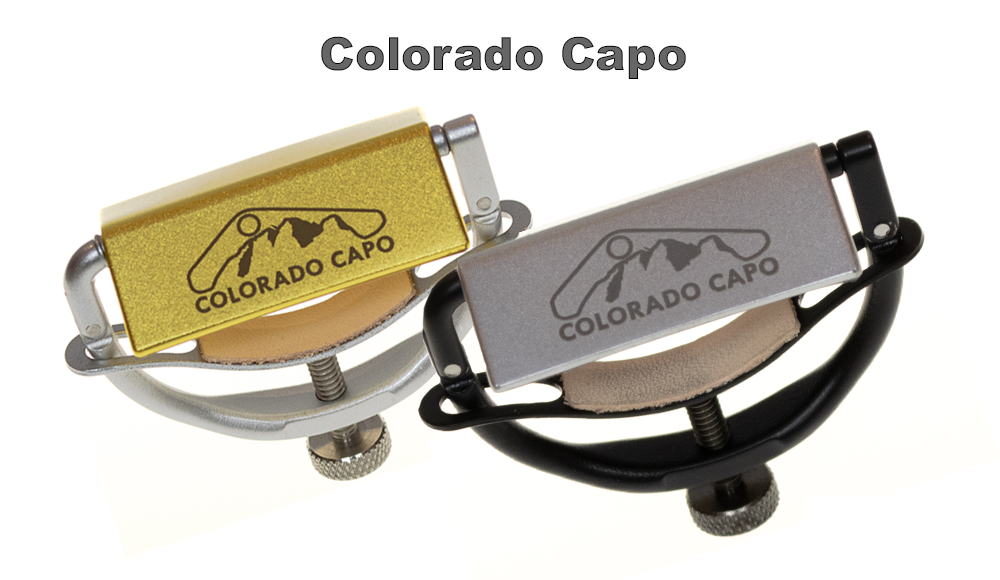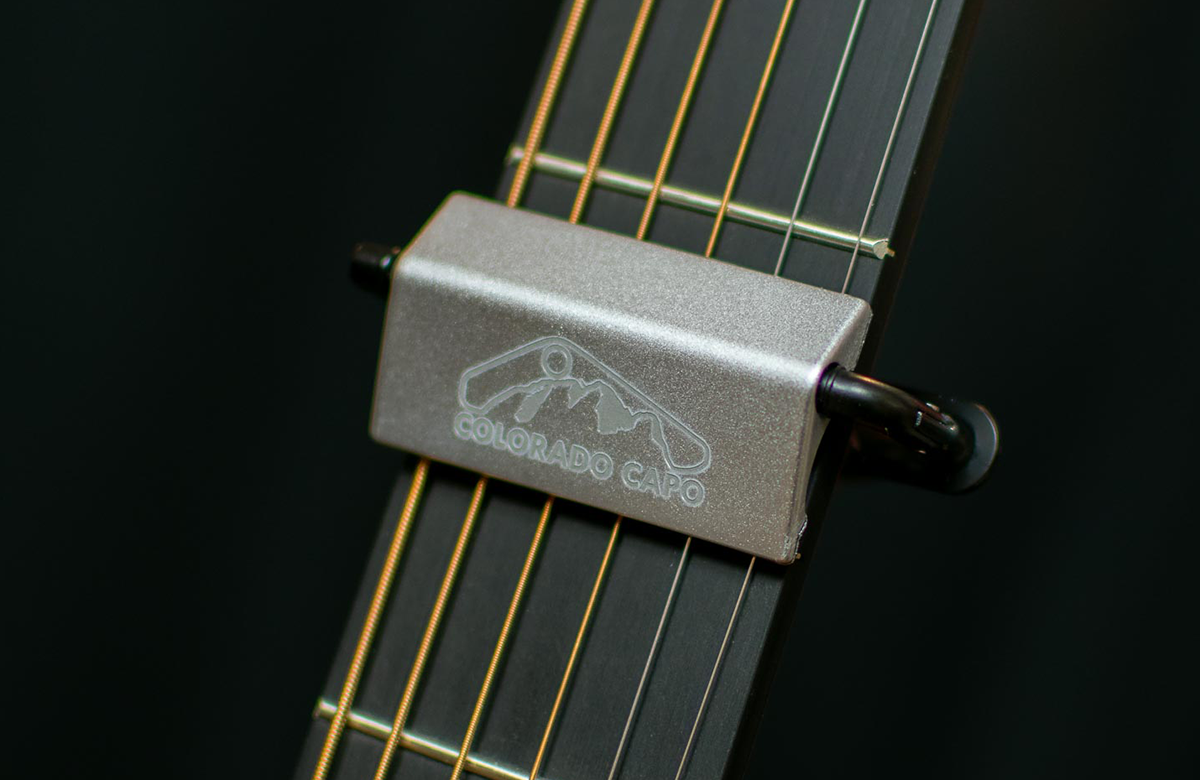The Colorado Capo
The Colorado Capo rises above your fretboard, sloping sleek and shapely as the majestic mountains of its namesake state.
This good looking piece of essential hardware was conceived by veteran musicians that engineered it to guarantee ergonomic comfort and excellent tone, while preserving accurate intonation that requires no re-tuning whatsoever.
Its attractive design is customizable, so you can get the exact sound and look that best fits your particular guitar and suits your unique style.

There’s never been another capo like it.
As long as there have been fretted instruments, there have been capos, which essentially shorten the neck, raising the pitch of the strings in the process. It allows musicians to instantly change the key of a song without having to re-learn new chord progressions.
Most modern guitarists need a capo at least once in a while. Others use one frequently. And all run into the same sorts of issues.
Strings go out of tune when a normal capo is attached to the neck. And the capo itself keeps intruding to make various chord shapes difficult to play, when the fretting hand has to fit under the neck near the capo.
The extraordinary Colorado Capo is the first capo to banish both of these pesky problems, permanently. And it is the first capo to effect zero dampening. All of the overtones are as clear and present as if you are using no capo at all! The secret to its success lies in the engineering.
A Unique Solution
Its creators first and foremost wanted a capo that would stay out of the way, so they could play hassle-free. This was accomplished by shifting the parts that hold the Colorado Capo in place farther down the neck from the part that depresses the strings to create the fretted notes. It is a unique solution to an age-old problem.
The innovative component of the Colorado Capo that puts pressure on the strings is called the “blade.” When the blade is positioned directly behind the fourth fret, for example, the part that is responsible for securing the capo to the back of the neck is positioned over half-way toward the third fret.
Having the blade projecting forward from the rest of the capo keeps the main structure well out of the way of the guitarist’s fretting hand. And the gradual slope to the blade’s silhouette is at its thinnest at the edge. So, it does not present an obstacle to the fingers, should they need to be positioned on top of one another at the first or second position.
Switching back to other capos makes the limitations of their old-fashioned designs annoyingly obvious. With the Colorado Capo, the player’s thumb can often rest comfortably on the side of the neck right where those other capos’ frames would be in the way.
The B7 Challenge
The inventors of the Colorado Capo like to use the first-position B7 as an example of a common chord that stacks the fingers on top of one another, while the back of the hand must be placed farther down the neck from the fingers.
Traditional capos get in the way of the hand when making this shape. That’s because the back of the capo is directly underneath the part that is depressing the strings. But the Colorado Capo offsets these two parts from one another, so there is plenty of room where the hand and thumb are grasping the back of the neck.
Maury took what he likes to call the “B7 Challenge” and was very impressed with how effortless it is to make that chord using the Colorado Capo, because of how its unique ergonomic design keeps the back of the capo from getting in the way of making music. And when players use the capo farther up the neck, where the frets are closer together, suddenly so many other chords become easier to accomplish than ever before.
No Re-Tuning Required
The typical intonation issues caused by other capos were likewise solved when they shifted the blade forward of the main structure. Under the front edge of the metal blade is a narrow bumper of a propriety material that is perfect for the purpose of fretting guitar strings. The Colorado Capo’s exclusive out-of-the-way design allows the blade to be placed right up against a fret, maintaining correct break angle, or "deflection," when the bumper depresses the strings.
No more setting the capo somewhere between the two frets to make room for the hand, which forces strings to sound sharp or flat as a result. The Colorado Capo’s ability to be seated directly behind a fret without getting in the way of the player’s hand eliminates the bothersome intonation issues caused by traditional capos.
A second bumper is placed along the back edge of the blade, allowing most of the string under the blade to remain free from pressure. Having two separate pressure points on the strings depresses the entire capo evenly, without the dampening effect that comes from using one wide pad, as found on other capos. It is so simple yet ingenious a solution that it seems amazing no one thought of this before. But now they have. And the results are very good indeed.
In fact, the patented Colorado Capo blades with their proprietary bumpers are so good at not dampening the tone of an acoustic guitar that they are actually superior to even the strongest guitarist’s index finger when clamping the six strings to create barre chords. Effectively, this capo creates a new nut wherever it is placed on the fretboard, and does so far better than anything that has come before it.

Classic Design Made Better
The Colorado Capo is based on a yoke design, so there is a U-shaped frame that has a padded cradle inside it, which is raised or lowered by a center screw, to gently embrace the neck and hold the capo in place. The cradle’s pad is as soft as moleskin, yet with the firm but forgiving density of cork. So, there is zero chance this capo will leave depressions in a finished guitar neck.
The blade fits onto a skewer atop one of the frame’s slender posts that is connected to a hinge, which opens and closes the blade like a toll gate, secured by a small latch on the opposite post. The guitarist positions the blade and then holds it in place as the screw is tightened at the back of the neck. As with all parts of the Colorado Capo, the screw is well made and quite sturdy, so it should last a lifetime of use.
While yoke-style capos require two hands to attach properly, they also offer guitarists the advantage of keeping the capo attached above nut when not in use, so it is always ready when you are. Just slide it up the neck and tighten the screw.
Once one becomes accustom to placing the Colorado Capo in the desired position for playing, it quickly becomes second nature. Just loosen the screw, slide it to another fret, and tighten, with no need to think up clever stage banter while searching your pockets for a capo, or re-tuning strings once you get it on the neck. And when a capo looks this good, placing it above the nut adds a touch of tasteful bling, thanks to the Colorado Capo’s elegant aesthetics.
Versatile Sizes and Tone Options
Another unique feature is the Colorado Capo’s interchangeable blades! At present, the blades come in two sizes and in two metal alloys. The sizes are 2.0" and 2.1”. The manufacturer recommends 2.0” for 1-11/16" & 1-3/4" nut width to 5th fret, and the 2.1" size for 1-7/8" & 1-3/4" nut width past 5th fret.
However, Maury’s Music would like to point out that most modern guitar necks with a 1-3/4” width at nut are not as wide in the upper frets as guitars made in the previous century, or those that recreate vintage guitar specifications.
For example, all modern Martin guitars made their High Performance Taper fretboards work with the standard 2.0” blade all the way up to the 9th fret, at least. And at every fret along the way, a guitarist hears the pure, unencumbered tone of their guitar, with unimpeded playability never before possible when using a capo high up the neck.


Silver and Gold
The Colorado Capo currently comes with two choices in blade material: The silvery aluminum blade and the golden brass blade. Each imparts a colorful influence on the tone produced by the guitar. The aluminum blade provides exceptional definition, clarity, and brilliance. The brass blade imparts a bit more bass and midrange presence. And both offers outstanding sustain. But the brass blade seems to produce more fundamental sustain, while the aluminum blade has unmatched sustain of the high harmonic overtones.
Which blade material is right for you? Why not try them both!
We have some users of the Colorado Capo who like to use the brass blade with their mahogany or maple guitars and the aluminum blade with rosewood guitars. Others have found they like the brass blade for songs with a lot of strumming, while preferring the aluminum blade for fingerstyle instrumentals. Others prefer them the other way around.
It is a matter of personal taste as to which blade one prefers and why. And for those who like to get persnickety with their performance and recording, using different blades for different songs, in combination with different tonewoods, and even different types of strings, can offer yet another parameter to tweak and geek.
Customized Artwork
The yoke is available in the alternative black variety. And the blades can be ordered with custom artwork, initials, or other text, which replace the Colorado Capo logo. Contact Maury’s Music to learn more about ordering a customized Colorado Capo!
One Excellent, Versatile Capo
Constructed with high-quality space age materials to be light yet strong, and crafted one capo at a time using the latest breakthroughs in modern manufacturing methods, the flawless Colorado Capo does everything right.
This is a premium product offered at a very reasonable price for such a welcome improvement over the usual capo designs. It makes a wonderful gift for your favorite guitarist! Even if that guitarist happens to be yourself.